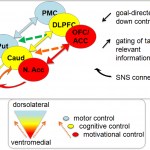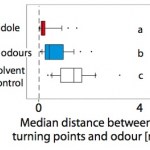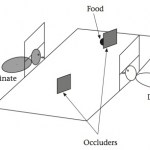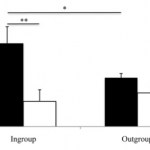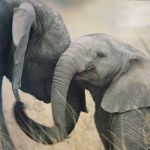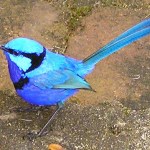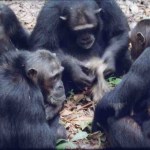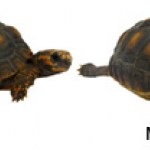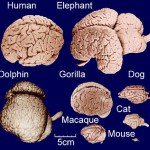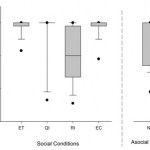Comparative Psychology
Stimulating the brain with high frequency electrical noise can supersede the beneficial effects observed from transcranial direct current stimulation, either anodal or cathodal (as well as those observed from sham stimulation), in perceptual learning, as newly reported by Fertonani, Pirully & Miniussi in the Journal of Neuroscience. The authors suggest that transcranial random noise stimulation may work by preventing those neurophysiological homeostatic mechanisms that govern ion channel conductance from rebalancing the changes induced by prolonged practice on this perceptual learning…
If you ever said to yourself, "I wonder whether the human mid- and posterior ventrolateral prefrontal cortex has a homologue in the monkey, and what features of its cytoarchitecture or subcortical connectivity may differentiate it from other regions of PFC" then this post is for you.
Otherwise, move along.
The mid/posterior ventrolateral prefrontal cortex (pars opercularis and pars triangularis, or Brodmann's Areas 44 and 45) is very clearly different, both anatomically and functionally, from its anterior sector (which involves the pars orbitalis, or Brodmann's Area 47). It is also probably…
A version of this post was originally published on my Wordpress blog on March 15, 2010. Click the archives image to see the original post.
Most animals, at some point in their day-to-day lives, face the same problem. After they've gone out in search of food, they need to find their way home. But some of the places where these critters live lack any real visual landmarks - like the open ocean or wide expanses of desert. Instead of relying on vision, some animals have developed the ability to use olfactory (scent-related) cues to aid in navigation. Seabirds can detect subtle changes in the…
You've probably had a conversation that goes something like this:
Person A: "My dog is sooooo amazing!"
You: "I mean, dogs are awesome and all, but what's so amazing about this particular dog?"
Person A: "He just understands me. It's like he knows what I'm thinking and what I need."
You: "Do you think he's just maybe responding contingently do your overt displays of emotion?"
Person A: "Listen, man, I'm telling you: my dog can read my mind!"
No matter on which side of this sort of argument you tend to fall, the question of whether or not domestic dogs can read human minds is an interesting…
Human infants have one important job during the first years of life, and that is to learn about the world and their culture from their parents and other caregivers. But what is learning? I've previously written that Hungarian developmental psychologists Gergely and Csibra have defined learning as the acquisition of new, generalizable knowledge that can later be used within a new context. Further, they have posited that evolution has prepared humans to learn generalizable knowledge from their caregivers. They proposed an elegant hypothesis: that a specialized innate pedagogy mechanism - called…
What is learning?
Most psychologists (indeed, most people in general) would agree that learning is the acquisition of new knowledge, or new behaviors, or new skills. Hungarian psychologists Gergely and Csibra offer a deceptively simple description: "Learning involves acquiring new information and using it later when necessary." What this means is that learning requires the generalization of information to new situations - new people, objects, locations, or events. The problem is that any particular piece of information that a human or animal receives is situated within a particular context…
You know that old phrase, "monkey see, monkey do"? Well, there might be something to it, except that chimpanzees aren't monkeys. (Sadly, "ape see, ape do" just doesn't have the same ring to it.) A new paper published today in PLoS ONE has found evidence that chimpanzees have contagious yawning - that is, they can "catch" yawns from watching other chimpanzees yawning - but (and here's the interesting part) only when the chimp that they're watching is a friend.
At first, scientists thought that contagious yawning was the result of a releasing mechanism - in other words, seeing someone yawn…
I was reading Christie's excellent post (and you should too) on GoDaddy CEO Bob Parsons' elephant killing incident (is it too early to be calling this #ElephantGate?)
Although I don't know quite enough about what is going on in Zimbabwe, I tend to err on the side of not intentionally killing elephants because - as I argued for the case of chimpanzees - they are very likely self-aware.
I wrote:
There is another important cognitive capacity that unites animals with high encephalization quotients (the ratio of brain to body size - I recommend going back to read my earlier post for the context…
A new piece by me today at the Scientific American Guest Blog, on some exciting news from the Jane Goodall Institute and Duke University:
Fifty years ago, in the summer of 1960 - the same year that a US satellite snapped the first photo of the Earth from space, the same year that the CERN particle accelerator became operational, the same year that the Beatles got their name - a 26-year-old Jane Goodall got on a plane in London and went for the first time to Gombe Stream Game Reserve, in Tanzania. She carried with her only a notebook and some old binoculars. Almost every day since the day…
Welcome to Territoriality Week! Every day this week, I'll have a post about some aspect of animal or human territoriality. How do animals mark and control their territories? What determines the size or shape of an animal's territory? What can an animal's territory tell us about neuroanatomy? Today, I begin by asking two questions: first, what is the functional purpose of establishing territories? Second, to what extent can we apply findings from research on animal territorial behavior to understanding human territorial behavior?
It seems that everyone becomes an amateur animal behaviorist…
What's the best way for a lonely guy to get a date? If you're a Splendid Fairy-Wren (Malurus splendens, native to Australia), your best bet might be to frighten the object of your affection.
You've learned all about the birds and the bees; now it's time to learn from them.
Lots of research has shown that animals reduce their sexual behaviors when predators are around. After all, it isn't just potential mates who would see or hear an elaborate mating display, but also potential predators. The male splendid fairy-wren does something a little bit unusual, though. Gray Butcherbirds (Cracticus…
In honor of Science Online, which begins on Thursday night, I will be writing about lemurs this week. Why lemurs? Because on Friday morning, as a part of Science Online, I will be taking a tour of the Duke Lemur Center.
It is common among animals - especially primates - to orient their gaze preferentially towards other individuals, as well as to follow the gaze of others. Lots of attention has been paid to gaze-following, in part because the ability to recognize and orient to the behavior of others is missing or impaired in various developmental disorders, such as autism. It is well known…
Eric M. Johnson and I spent about 45 minutes discussing "evolutionary psychology beyond sex" last night, which you can see today on Bloggingheads "Science Saturday."
Or just watch it here:
"Two chimps had been shut out of their shelter by mistake during a cold rain storm. They were standing dejeted, water streaming down their shivering bodies, when Professor Köhler chanced to pass." Upon opening the door for the two chimps, Dr. James Leuba recounts, "instead of scampering in without more ado, as many a child would have done, each of them delayed entering the warm shelter long enough to throw its arms around his benefactor in a frenzy of satisfaction."
"Chimpanzees," primatologist Frans de Waal points out, "do not normally hug their caretakers for no reason." It's a compelling…
Scientists thought they had a pretty good handle on the social interactions of bottlenose dophins (Tursiops). They've used the term fission-fusion dynamics to describe dolphin (and non-human primate) society and so far it has served researchers well. Fission-fusion societies among dolphins are characterized by two levels of social hierarchy: groups of two or three related males ("first-order alliances") which work together to guard one or more females from other males, and larger teams comprised of multiple related first-order alliances ("second-order alliances") which cooperate to "steal"…
Have you ever been at a party with lots of people chatting away, when for some unexplainable reason you felt compelled to turn and look at the front door of your friend's house...and just as you were looking, someone was just coming in from outside and closing the door? You couldn't have heard the door open since there was so much noise already inside - more likely you noticed that other people were looking at the front door. All of this probably happened without any explicit intention or awareness. If several others are all directing their attention at a specific point in space, there might…
A really excellent PBS CBC (thanks m5) documentary on the surprising cognitive abilities of crows:
Watch the full episode. See more Nature.
See also how crows might be trained to do something a little more lucrative:
This latter video tells a great story, but as John Hawkes has pointed out, there is perhaps some confusion about how successful Josh Klein's more lucrative experiments actually were.
Meet Rio.
Rio is a California Sea Lion (Zalophus californianus). She was born in captivity at Marine World in Northern California, and due to insufficient maternal care from her biological mother, she was transferred to the Long Marine Laboratory at UC Santa Cruz when she was just a few days old. There, she was raised by a human surrogate mother, in the context of an imprinting study. She's got a pretty good life. She gets all the fish she could want, and has 3 other pinniped (seals, sea lions, otters) friends at the lab. There's Burnyce, a female Northern elephant seal, Sprouts, a male…
The National Institutes of Health announced that by 2011 it will transfer almost two hundred chimpanzees from the Alamogordo Primate Facility in New Mexico to a lab in San Antonio, Texas, lab for use in invasive research. In 1995, the NIH announced a moratorium on the breeding of chimps in federally-supported labs, and as a result, scientists have developed alternative ways to investigate diseases. But there are still viruses, such as hepatitis C and HIV, that other species simply can't contract. This fact, some argue, makes it prudent to subject chimps to this sort of biomedical testing.…
Cooperation and conflict are both a part of human society. While a good deal of the academic literature addresses the evolutionary origins of conflict, in recent years there has been an increased focus on the investigation of the evolutionary origins of cooperative behavior. One component of cooperative behavior that might be present in other animals is aversion to inequity. Some scientists have suggested that inequity aversion may itself be the main factor driving the enforcement of cooperation. Put simply, inequity aversion is the resistance among partners to unequal rewards following…
